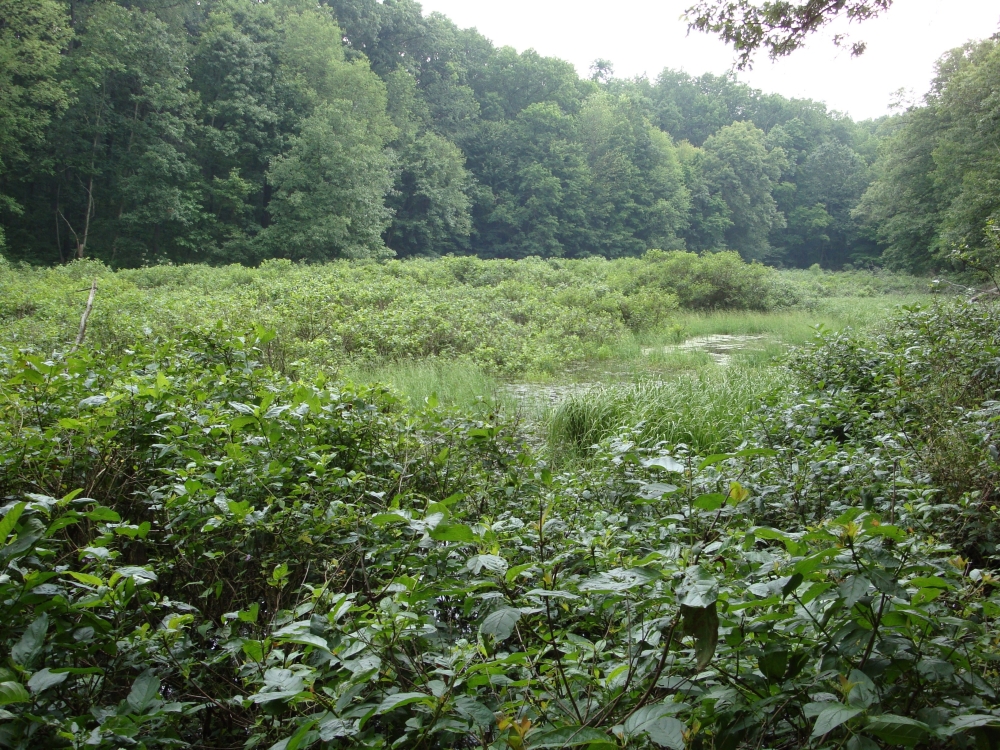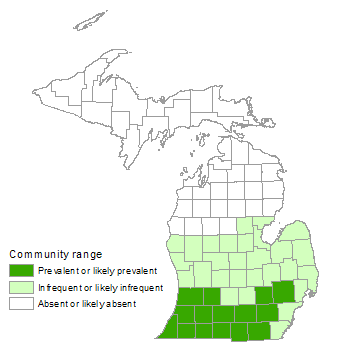Inundated Shrub Swamp
Overview
Inundated shrub swamp is a shrub-dominated community characterized by poor drainage, nearly continuous inundation or saturation, and dominance by buttonbush (Cephalanthus occidentalis). The community typically exhibits a scattered shrub-dominated overstory and sparse herbaceous cover.
Rank
Global Rank: G4 - Apparently secure
State Rank: S3 - Vulnerable

Landscape Context
This community occupies kettleholes in ice-contact topography and moats around bogs, and is occasionally found in wetland depressions on outwash and sandy lakeplains. Inundated shrub swamp typically occurs in isolated depressions (i.e., ice-block depressions) surrounded by forested uplands of mesic southern forest, dry-mesic southern forest, or dry southern forest.
Soils
Soils are typically shallow muck over gleyed clay, silty clay, or sandy clay. Soil pH ranges from strongly acid to moderately alkaline, with organic portions of the soil profile being more acidic than mineral portions. Although soil typically remains inundated throughout the year due to the underlying impermeable clay, the upper soil layers may become dry in mid to late summer and during periods of persistent drought.
Natural Processes
Inundated shrub swamp is successionally intermediate between open emergent marsh and swamp forest. The community becomes established as shrubs tolerant of prolonged, inundated conditions invade open wetlands. Frequent disturbances such as seasonal hydrologic cycling and prolonged flooding allow inundated shrub swamp to persist rather than succeed to swamp forest. Water often pools for prolonged periods of time due to the impermeable clay layer in the soil profile, which limits tree establishment and growth. Additionally, beaver herbivory can limit tree longevity and help maintain inundated shrub swamp. While major flood events and beaver flooding kill invading trees, contributing to the persistence of inundated shrub swamp, extended periods of drought or hydrologic changes that lower the water table foster tree establishment and conversion to swamp forest.
Vegetation
Inundated shrub swamps are characterized by dominance of buttonbush, which typically represents more than 50% of the shrub cover. Buttonbush is well adapted to fluctuating water tables, constant inundation, and a broad range of pH levels, allowing it to outcompete many other tree and shrub species. Research suggests a minimum water depth of 0.5 m (20 in) is needed for successful maintenance of buttonbush populations, and the species is typically restricted to emergent or inundated zones. Although buttonbush responds favorably to increased light levels, high light levels are not critical for its establishment.
In addition to buttonbush, other common species in the shrub layer of inundated shrub swamps include willows (i.e., Salix bebbiana and S. discolor), red-osier dogwood (Cornus sericea), silky dogwood (C. amomum), winterberry (Ilex verticillata), black chokeberry (Aronia prunifolia), swamp dewberry (Rubus hispidus), and swamp rose (Rosa palustris). Shrub cover can range from 40 to 90%, with an average of 70%. Often a scattered tree canopy is also present and may include maples (i.e., Acer rubrum, A. saccharinum, and A. saccharum), yellow birch (Betula alleghaniensis), musclewood (Carpinus caroliniana), ashes (i.e., Fraxinus nigra and F. pennsylvanica), black walnut (Juglans nigra), oaks (i.e., Quercus bicolor and Q. palustris), black willow (Salix nigra), and American elm (Ulmus americana). In a survey of 13 inundated shrub swamps in southern Michigan, tree overstory cover ranged from 5 to 60%, with an average cover of 23%.
Although the amount of ground cover can vary greatly both within and among inundated shrub swamps, the herbaceous layer is typically fairly sparse due to frequent and prolonged flooding. The ground flora may contain species such as short-awned foxtail (Alopecurus aequalis), swamp milkweed (Asclepias incarnata), common beggar ticks (Bidens frondosa), false nettle (Boehmeria cylindrica), sedges (Carex stricta, C. intumescens, C. retrorsa, C. radiata, C. lacustris, and C. crinita), water hemlock (Cicuta bulbifera), goldthread (Coptis trifolia), spinulose woodfern (Dryopteris carthusiana), jewelweed (Impatiens capensis), southern blue flag (Iris virginica), rattlesnake grass (Glyceria canadensis), small duckweed (Lemna minor), common water horehound (Lycopus americanus), northern bugle weed (L. uniflorus), tufted loosestrife (Lysimachia thyrsiflora), Canada mayflower (Maianthemum canadense), sensitive fern (Onoclea sensibilis), cinnamon fern (Osmunda cinnamomea), Virginia chain-fern (Woodwardia virginica), reed canary grass (Phalaris arundinacea), clearweed (Pilea pumila), puccinellia (Torreyochloa pallida), mad-dog skullcap (Scutellaria lateriflora), water parsnip (Sium suave), bur-reeds (Sparganium spp.), skunk cabbage (Symplocarpus foetidus), and starflower (Trientalis borealis).
For information about plant species, visit the Michigan Flora website.
Plant Lists
Graminoids
- short-awned foxtail (Alopecurus aequalis)
- blue-joint (Calamagrostis canadensis)
- sedges (Carex crinita, C. intumescens, C. lacustris, C. radiata, C. retrorsa, C. stricta, and others)
- three-way sedge (Dulichium arundinaceum)
- rattlesnake grass (Glyceria canadensis)
- floating manna grass (Glyceria septentrionalis)
- fowl manna grass (Glyceria striata)
- wool-grass (Scirpus cyperinus)
- puccinellia (Torreyochloa pallida)
Forbs
- swamp milkweed (Asclepias incarnata)
- nodding bur-marigold (Bidens cernua)
- common beggar-ticks (Bidens frondosa)
- false nettle (Boehmeria cylindrica)
- water hemlock (Cicuta bulbifera)
- jewelweed (Impatiens capensis)
- southern blue flag (Iris virginica)
- small duckweed (Lemna minor)
- common water horehound (Lycopus americanus)
- northern bugle weed (Lycopus uniflorus)
- tufted loosestrife (Lysimachia thyrsiflora)
- clearweed (Pilea pumila)
- mad-dog skullcap (Scutellaria lateriflora)
- water parsnip (Sium suave)
- bur-reeds (Sparganium spp.)
- skunk-cabbage (Symplocarpus foetidus)
- common cat-tail (Typha latifolia)
Ferns
- sensitive fern (Onoclea sensibilis)
- cinnamon fern (Osmunda cinnamomea)
- Virginia chain-fern (Woodwardia virginica)
Woody Vines
- poison-ivy (Toxicodendron radicans)
Shrubs
- black chokeberry (Aronia prunifolia)
- buttonbush (Cephalanthus occidentalis)
- silky dogwood (Cornus amomum)
- gray dogwood (Cornus foemina )
- red-osier dogwood (Cornus sericea)
- whorled loosestrife (Decodon verticillatus)
- winterberry (Ilex verticillata)
- swamp rose (Rosa palustris)
- swamp dewberry (Rubus hispidus)
- Bebb’s willow (Salix bebbiana)
- pussy willow (Salix discolor)
- highbush blueberry (Vaccinium corymbosum)
Trees
- red maple (Acer rubrum)
- silver maple (Acer saccharinum)
- yellow birch (Betula alleghaniensis)
- musclewood (Carpinus caroliniana)
- ashes (Fraxinus nigra and F. pennsylvanica)
- black gum (Nyssa sylvatica)
- cottonwood (Populus deltoides)
- swamp white oak (Quercus bicolor)
- pin oak (Quercus palustris)
- black willow (Salix nigra)
- American elm (Ulmus americana)
Noteworthy Animals
The community provides critical breeding habitat to amphibians and aquatic invertebrates. Snakes utilize the community for foraging habitat. In particular, the northern water snake and copperbelly watersnake (Nerodia erythrogaster neglecta, federal threatened and state endangered) feed on frogs that utilize the inundated shrub swamp.
Rare Plants
- Wolffia papulifera (water-meal, state threatened)
Rare Animals
- Acris crepitans blanchardi (Blanchard’s cricket frog, state special concern)
- Ambystoma texanum (smallmouth salamander, state endangered)
- Clemmys guttata (spotted turtle, state threatened)
- Emydoidea blandingii (Blanding’s turtle, state special concern)
- Heteropacha rileyana (Riley’s lappet moth, state special concern)
- Heterocampa subrotata (small heterocampa, state special concern)
- Nerodia erythrogaster neglecta (copperbelly water snake, federal threatened and state endangered)
- Nycticorax nycticorax (black-crowned night-heron, state special concern)
- Papaipema speciosissima (regal fern borer, state special concern)
- Terrapene c. carolina (eastern box turtle, state special concern)
- Williamsonia fletcheri (ebony boghaunter, state special concern)
Biodiversity Management Considerations
Anthropogenic hydrologic alterations caused by dams, road-building, draining and ditching, agriculture, logging, and urban development can stabilize or permanently change water tables, thereby threatening the ecological integrity of inundated shrub swamps. Additionally, incompatible land uses in the surrounding landscape can result in excess nutrients, sediments, and chemicals entering the community, where they can alter nutrient cycles and species composition. A well-established buffer of natural communities helps maintain natural hydrology and reduce nutrient-loading.
Invasive species documented from inundated shrub swamps in Michigan include glossy buckthorn (Frangula alnus), multiflora rose (Rosa multiflora), autumn olive (Elaeagnus umbellata), reed canary grass, garlic mustard (Alliaria petiolata), Canada thistle (Cirsium arvense), moneywort (Lysimachia nummularia), curly dock (Rumex crispus), horse nettle (Solanum carolinense), and bittersweet nightshade (S. dulcamara). Given the potential for invasive species to outcompete native vegetation and alter community structure, monitoring and control efforts to detect and remove invasive species are a crucial component of protecting high quality inundated shrub swamp communities.
Variation
Community size, basin morphology, presence and depth of water, and species composition can all vary significantly among inundated shrub swamps, even where they occur in close proximity to one another.
Similar Natural Communities
Emergent marsh, northern shrub thicket, and southern shrub-carr.
Places to Visit
- Black River Shrub Swamp, Port Huron State Game Area, St. Clair Co.
- Crane Pond State Game Area, Cass Co.
- Crooked Lake Shrub Swamp, Pinckney State Recreation Area, Washtenaw Co.
- Three Rivers State Game Area, Cass Co. and St. Joseph Co.
- Trout Lake, Bald Mountain State Recreation Area, Oakland Co.
Relevant Literature
- Faber-Langendoen, D., and S.J. Dina. 1987. Growth responses of Cephalanthus occidentalis L. (buttonbush) to varying light levels and flooding. Transactions of the Missouri Academy of Science 21. Pp. 55-62.
- Faber-Langendoen, D., and P.F. Maycock. 1989. Community patterns and environmental gradients of buttonbush, Cephalanthus occidentalis, ponds in lowland forests of southern Ontario. Canadian Field-Naturalist 103: 479-485.
- Faber-Langendoen, D., ed. 2001. Plant communities of the Midwest: Classification in an ecological context. Association for Biodiversity Information, Arlington, VA. 61 pp. + appendix (705 pp.).
- Kost, M.A., Y.M. Lee, J.G. Lee, and J.G. Cohen. 2006. Habitat characterization and evaluation of community types utilized by copperbelly watersnake (Nerodia erythrogaster neglecta) in Michigan and northern Ohio. Michigan Natural Features Inventory Report No. 2006-02, Lansing, MI. 20 pp. + appendices.
- Tyrell, L.E. 1987. A floristic survey of buttonbush swamps in Gahanna Woods State Nature Preserve, Franklin County, Ohio. Michigan Botanist 26(1): 29-37.
For a full list of references used to create this description, please refer to the natural community abstract for Inundated Shrub Swamp.
More Information
Citation
Cohen, J.G., M.A. Kost, B.S. Slaughter, D.A. Albert, J.M. Lincoln, A.P. Kortenhoven, C.M. Wilton, H.D. Enander, and K.M. Korroch. 2020. Michigan Natural Community Classification [web application]. Michigan Natural Features Inventory, Michigan State University Extension, Lansing, Michigan. Available https://mnfi.anr.msu.edu/communities/classification. (Accessed: April 28, 2025).
Kost, M.A., D.A. Albert, J.G. Cohen, B.S. Slaughter, R.K. Schillo, C.R. Weber, and K.A. Chapman. 2007. Natural Communities of Michigan: Classification and Description. Michigan Natural Features Inventory, Report No. 2007-21, Lansing, MI.


